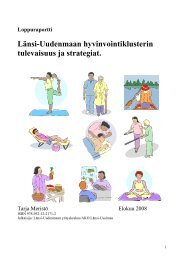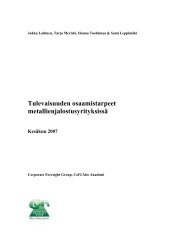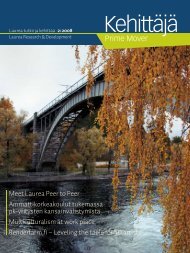849954 sisus
849954 sisus
849954 sisus
Create successful ePaper yourself
Turn your PDF publications into a flip-book with our unique Google optimized e-Paper software.
the interaction process, which contains exchange, adaptation, and coordination<br />
processes. 3<br />
For the analysis of relationships and networks the contribution of the model is<br />
noteworthy, as it explains the outcomes (e.g. changing roles) as a result of multiple<br />
bonds. Besides, the outcome is a result of interaction on diverse managerial<br />
levels (formal, informal), including constant assessment of satisfaction as well.<br />
As depicted in Fig. 1, technology can be seen as a crucial element in the interaction<br />
process, as technology means a process of transforming inputs to outputs.<br />
In organisational technology, a sequence of events is defined: admission of input<br />
(e.g. knowledge) into the organisation, conversion of this input to output (through<br />
application of skills) and disposal of the output into the environment (Han 1997,<br />
23). On the technology level the adaptation of adequate technology is of a major<br />
interest in the process of interorganisational behaviour. It can have an impact on<br />
social relationships and bonding as well.<br />
It can also be claimed that relationships as basic constructs in a particular network<br />
are resources and they have value. Wilson and Jantrania (1997, 300) describe<br />
value with three different dimensions: economic, behavioural and strategic;<br />
in the strategic dimension an actor aims at gaining competitive advantage or<br />
strives to strengthen the core competencies.<br />
3 The original model proposed by Möller and Wilson (1995) has several applications in different contexts<br />
(e.g. Frankel et al. 1996, Han 1997, Halinen 1994); e.g. in the study by Halinen (1994) the indispensable<br />
prerequisites for establishing a relationship are addressed as well as the perceived outcomes<br />
of an interaction process. Adaptation as a component in bonding, as well as its dimensions -<br />
social, technological or other - have been investigated, though not with logistical issues in focus (Hallen<br />
et al. 1991, Wilson and Jantrania 1997, Han 1997, Naude and Turnbull 1997, Williamson 1991).<br />
Regarding the interaction model by Möller and Wilson (1995) and the strong emphasis on processes,<br />
Pettigrew (1998) proposes five features that should be viewed in processual analysis: embeddedness,<br />
studying processes across a number of levels of analysis, temporal interconnectedness, studying<br />
processes in past, present, and future time, role in explanation for context and action, search for<br />
holistic rather than linear explanations of processes, and a need to link the process to the location<br />
and explanation of outcomes. Pettigrew’s proposal (1998) is consistent with that of scholars who have<br />
explained and utilised processual analysis (e.g. Tikkanen 1997, Halinen 1994).<br />
45








